|
 Hygrocybe fuliginata Hygrocybe fuliginata
SynonymsHygrocybe spadicea
Hygrophorus fuscoaurantiacus
BiostatusPresent in region - Indigenous. Endemic
Images (click to enlarge)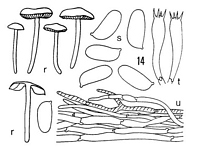
Caption: Hygrocybe fulignata Hk. (type): r. carpophores. - s. spores. - t. basidia. - u. cuticle | 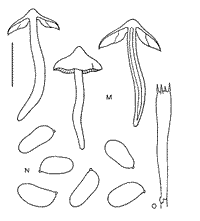
Caption: Fig. 16 Hygrocybe fuliginata Horak.(M-O: ZT 68/558): M.
basidiomes. N. spores. O. basidium. | 
Caption: Watercolour
Owner: G.M. Taylor | 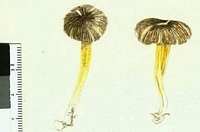
Owner: G.M. Taylor | 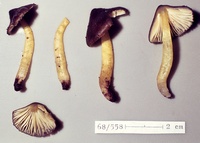
Caption: ZT68-558
Owner: E. Horak: © Creative Commons Attribution-Noncommercial 3.0 New Zealand | 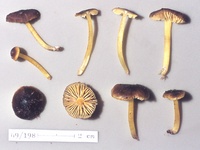
Caption: ZT69-198 , Holotype
Owner: E. Horak: © Creative Commons Attribution-Noncommercial 3.0 New Zealand | 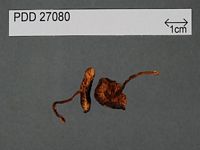
Caption: Dried type specimen
Owner: Herb PDD | 
Caption: Hygrocybe spadicea (Fries): n. carpophores. - o. spores. - p. basidia. - q. cuticle (Herb. HK. ZT 68/558) | |
Article: Horak, E. (1990). Monograph of the New Zealand Hygrophoraceae (Agaricales). New Zealand Journal of Botany 28(3): 255-306 (http://www.rsnz.org/publish/abstracts.php).
Description: Pileus - 5 mm, hemispherical to conical becoming convex to expanded, with or
without distinct conical or obtuse umbo; dark brown to soot brown, yellow towards
the non-striate margin, densely covered with concolorous, radially arranged,
coarse fibrils; viscid when wet. -Lamellae 14-25 (1 -7) adnexed to adnate-emarginate,
decurrent with short tooth, ventricose; golden yellow to pale yellow (occasionally
with grey tint), orange-red tints absent, edges entire or eroded, concolorous.
- Stipe 20-50 x 2-5 mm, cylindrical, equal to subfusoid: golden, yellow to chrome
yellow, paler towards base; dry, glabrous, fistulose, single or caespitose.
- Context yellow, brown beneath cuticle of pileus, unchanging. - Odour and taste
not distinctive. - Chemical reactions on pileus: KOH, HCI, and NH3
- negative.
Spores 7-11 x 4-5.5 um, ellipsoid to subcylindrical. - Basidia 35-50 x 7-8
um, 4-spored. - cystidia absent. - Pileipellis an ixocutis of cylindrical, gelatinised
hyphae (3-10 um diam.), with brown (KOH) plasmatic pigment; clamp connections
present (Pl. 1, Fig. 7).
Habitat: ECOLOGY: Scattered; saprobic on soil among litter in broadleaved forests (Leptospermum,
Weinmannia, Metrosideros, Schefflera). March-June.
Distribution: DISTRIBUTION: NZ (T,SL).
Article: Horak, E. (1973). Fungi Agaricini Novazelandiae I-V. Beihefte zur Nova Hedwigia 43: 200 p.
Description: Pileus 10-25 mm diam., hemispherical when young becoming convex to flat, sometimes with indistinct umbo, deep brown to sooty brown, yellow towards the often splitting, unstriated margin, densely covered with concolorous, radially arranged fibrils, viscid when wet. Lamellae emarginate-adnexed, decurrent with short tooth, ventricose, golden yellow, unchanging, gill edge even or undulated. Stipe 20-35 x 1.5-3 mm, equal, single or in clusters, golden yellow, paler towards the base, dry, glabrous, fistulose. Context deep yellow, brown beneath the cuticle, unchanging. Taste and odor not distinctive. Chemical reactions on pileus: KOH, NH3 and HCl- negative.
Spores 8.5-11 x 4 -5 µm, elliptic to subcylindric, smooth, hyaline, inamyloid. Basidia 34-38 x 7 µm, 4-spored. Cystidia absent. Cuticle a cutis consisting of repent, cylindric, hyaline hyphae (3-10 µm diam.), membranes slightly gelatinized, brown plasmatic pigment present. Clamp connections numerous.
Habitat: Amongst mosses under Leptospermum scoparium (and Nothofagus cliffortioides ). New Zealand.
Notes: This is a beautiful and delicately coloured Hygrocybe which resembles H. spadicea (Fr.). However, the size and shape of the spores, the shape of the pileus and the colours are different.
Article: Horak, E. (1973). Fungi Agaricini Novazelandiae I-V. Beihefte zur Nova Hedwigia 43: 200 p.
Description: Pileus 15-45 mm diam., conic to campanulate, umbo present, sooty brown to dark brown, occasionally with faint olive tints, pale yellowish towards the striated margin, densely covered with concolorous, radially arranged fibrils, viscid when moist. Lamellae adnexed to free, yellowish when young turning grey-yellow to orange, gill edge concolorous, even. Stipe 30-60 x 3-6(-10) mm, tapering towards the base, slightly fusoid, lemon yellow, paler at the base, dry, covered with longitudinal fibrils, fistulose, single. Context yellowish" with a brown layer beneath the cuticle. Taste and odor not distinctive" Chemical reactions on pileus: KOH - negative.
Spores 7-10 x 4-5.5 µm, ovoid, inamyloid, smooth. Basidia 40-52 x 6-9 µm, 4-spored. Cystidia lacking. Cuticle a cutis consisting of repent, cylindric, slightly gelatinized hyphae (2-7 µm diam.), subcutis of chains of subfusoid cells, brown, plasmatic pigment present. Clamp connections numerous.
Habitat: In soil amongst litter and mosses under Weinmannia racemosa, Beilschmiedia tawa, Metrosideros, Schefflera, etc. New Zealand.
Notes: The N.Z. collections studied which are referable to H. fusco-aurantiaca (Stev.) appear to be conspecific with H. spadicea (Fr.), in spite of the fact that some minor characters are different. According to the original description H. inocyboides Heim (1967) collected under oak in New Guinea, also very much resembles H. spadicea (Fr.).
|